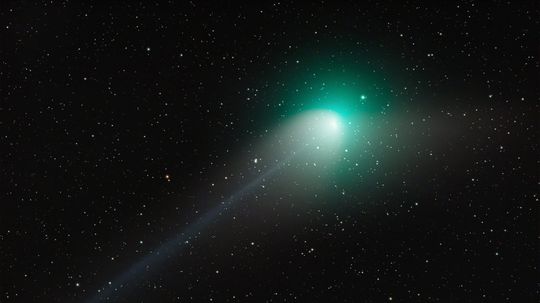Have you ever wondered why some comets appear green in the night sky? Well, let me tell you, it’s not just a random occurrence! There are fascinating scientific reasons behind this mesmerizing phenomenon that will leave you in awe.
The Enigmatic Glow of Green
When we gaze at the heavens and spot a green comet streaking across the darkness, it’s hard not to feel a sense of wonder. But what causes this celestial spectacle? The answer lies within the composition of these cosmic wanderers.
You see, comets are made up of various elements and compounds such as water ice, dust particles, carbon dioxide, methane gas, and more. When they approach our Sun during their elliptical orbits from the far reaches of space, something magical happens.
The intense heat from our star causes these volatile substances to vaporize and release energy in different forms. One particular process called “fluorescence” is responsible for producing that enchanting emerald hue we associate with green comets.
A Dance with Solar Radiation
Solar radiation plays a crucial role in transforming ordinary-looking comets into radiant emerald beauties. As sunlight interacts with the released gases and dust surrounding these icy bodies, an extraordinary reaction occurs.
The ultraviolet (UV) light emitted by our Sun excites atoms within the coma – a glowing cloud surrounding the nucleus of a comet – causing them to emit visible light. This emission often appears as shades of green due to specific chemical compounds present in abundance on certain cometary surfaces.
Molecules like diatomic carbon (C₂), cyanogen (CN), and formaldehyde (CH₂O) have been identified as key contributors to this captivating color display. Their unique molecular structures absorb UV light and re-emit it as green or blue-green light, creating a breathtaking spectacle for us to behold.
A Celestial Kaleidoscope
Comets are like cosmic canvases, each with its own distinct blend of colors. While green is the most common hue observed in these celestial wonders, other shades such as yellow, orange, and even red can also be seen.
The exact color palette of a comet depends on several factors including the types and quantities of chemicals present in its composition. For instance, comets rich in carbon compounds may exhibit a yellowish glow due to emissions from diatomic carbon molecules.
Furthermore, the size and density of dust particles surrounding the nucleus can influence how sunlight interacts with them. This interaction can scatter certain wavelengths of light more effectively than others, resulting in variations in color intensity.
In Awe of Nature’s Splendor
As we ponder upon the mysteries of our universe, let us not forget to marvel at the beauty that lies within our reach. The sight of a green comet gracefully traversing across the night sky serves as a reminder that there is still so much left to discover about our vast cosmos.
So next time you catch a glimpse of one these celestial wonders donning their emerald attire, take a moment to appreciate nature’s artistry and revel in its awe-inspiring splendor!


